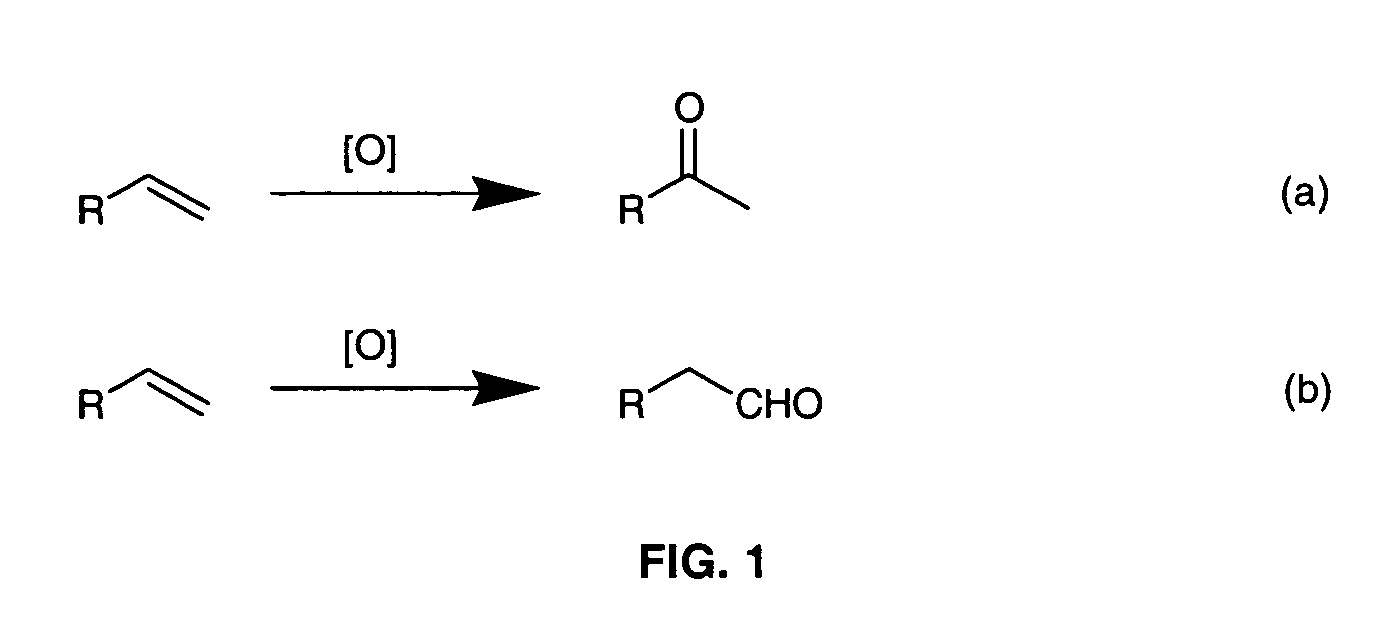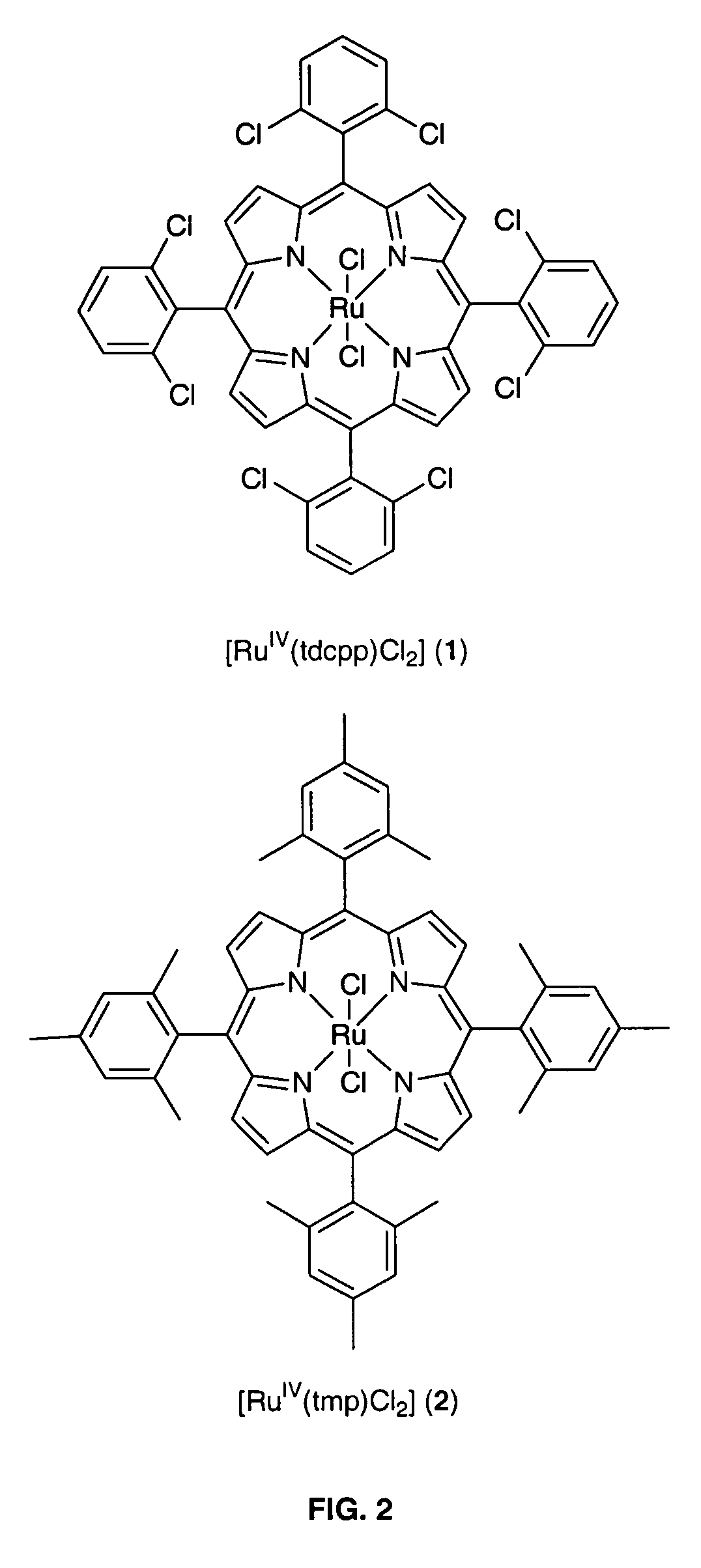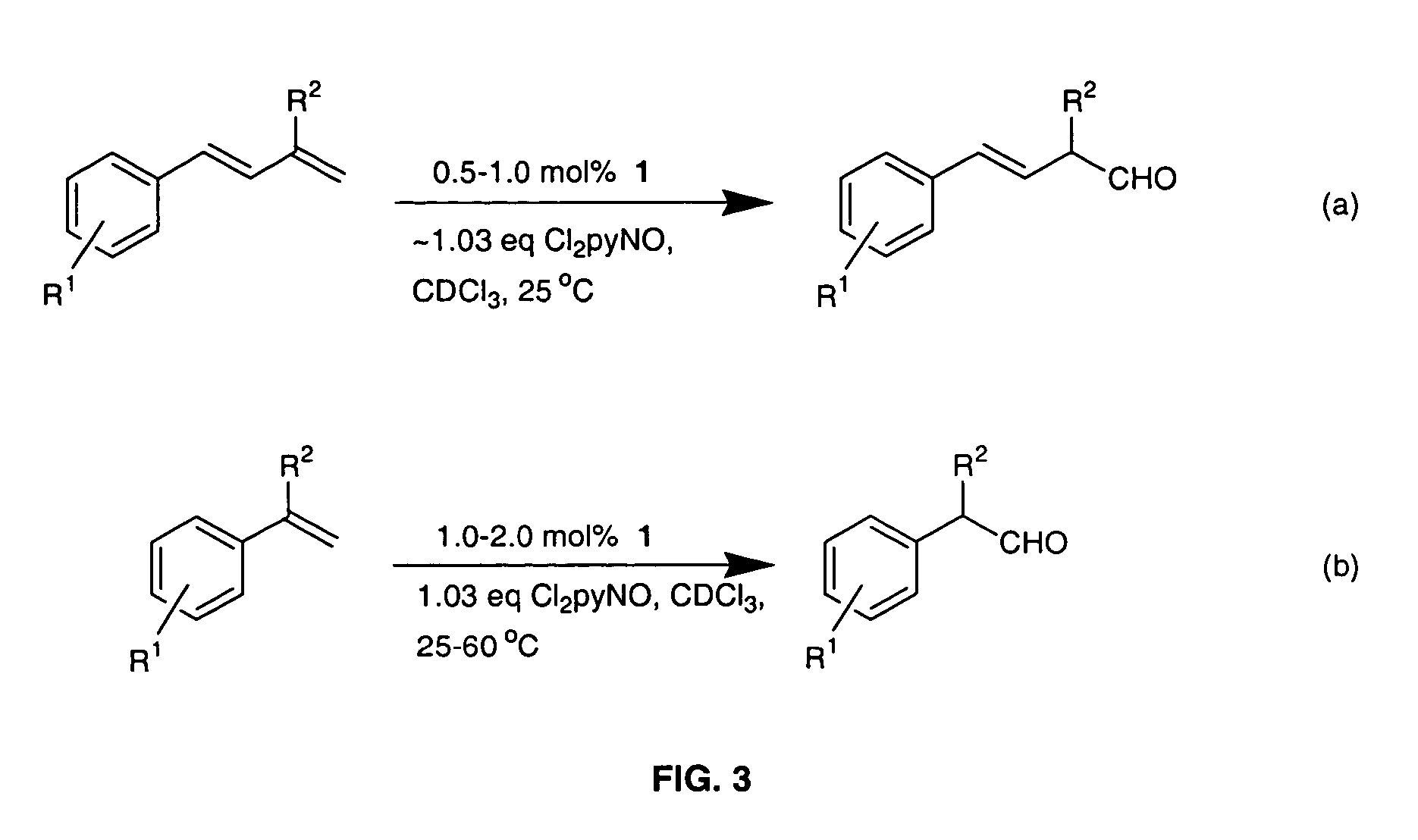Method for conversion of terminal alkenes to aldehydes using ruthenium (IV) porphyrin catalysts
a technology of porphyrin and terminal alkenes, which is applied in the preparation of carbonyl compounds, heterocyclic compounds, organic chemistry, etc., to achieve good-to-excellent yields and high regioselective formation
- Summary
- Abstract
- Description
- Claims
- Application Information
AI Technical Summary
Benefits of technology
Problems solved by technology
Method used
Image
Examples
example 1
Regioselective Conversion of Terminal Alkenes to Aldehydes Via a Subsequent Epoxidation / Isomerization Route Catalyzed by Either Dichlororuthenium(IV) Porphyrins 1 or 2
[0018]The invention relates to a practical and mild method for the synthesis of aldehydes using either dichlororuthenium(IV) porphyrins 1 or 2 (prepared according to Leung et al. J. Chem. Soc. Dalton Trans (1997), page 237) as general and effective catalysts for the oxidation of terminal alkenes.
[0019]Typical conditions employ 0.1 mmol of alkene substrate, Cl2pyNO (1.03 equiv), and 1 (0.5-2.0 mol %) dissolved in CDCl3 (0.5-1.0 mL) in a NMR tube at room temperature or 60° C. The progress of the reaction was monitored by 1H NMR. After determination of the product yield by 1H NMR spectroscopy, the reaction mixture was separated by flash chromatography on silica gel. For the large-scale reaction, 0.65 mmol of alkene substrate, Cl2pyNO (1.03 equiv), and 1.0 mol % of 1 in 10 mL of CHCl3 were used and reaction was carried out...
example 2
Regioselective Conversion of Terminal Alkenes to Aldehydes Via a Subsequent Epoxidation / Isomerization Route Catalyzed by Either Dichlororuthenium(IV) Porphyrins 1 and In-Situ Olefination with Ethyl Diazoacetate in the Presence of PPh3, Leading to One-Pot Diazoacetate Olefination Starting from Alkenes
[0027]Recently, Woo (Woo et al. J. Am. Chem. Soc. (2002), Vol. 124, page 176), Aggarwal (Aggarwal et al. J. Am. Chem. Soc. (2003), Vol. 125, page 6034), and Zhang (Zhang et al. J. Org. Chem. (2003), Vol. 68, page 3714) reported that iron or ruthenium meso-tetraaryl porphyrins [FeII(ttp)], [FeIII(tpp)Cl], or [RuII(tpp)(CO)] can catalyze the olefination of certain classes of aldehydes with ethyl diazoacetate (EDA) in the presence of PPh3. We observed that both 1 and [RuII(tdcpp)(CO)] could also catalyze such olefination reactions. Recognizing that the aldehyde products in the 1-catalyzed E-I reactions could be in-situ used as the substrates for olefination reactions, we were interested in ...
example 3
Preparation of Synthetically Organic Compounds by Application of the Dichlororuthenium(IV) Porphyrin Catalyzed Oxidation of Silyl Enol Ethers
[0030]4-Oxoarylbutanal derivatives are useful compounds for organic synthesis. For example, the preparation and application of 4-oxo-4-phenylbutanal (39) have been extensively studied in the literature. (Kruse et al. Heterocycles (1987), Vol. 26, page 3141; Molander et al. Tetrahedron Lett. 1989, Vol. 30, page 2351; Molander et al. J. Org. Chem. (1991), Vol. 56, page 2617; Molander et al. J. Am. Chem. Soc. 1993, Vol. 115, page 830; Savoia et al. Tetrahedron Lett. (1994), Vol. 35, page 2775; Utimoto et al. Tetrahedron Lett. (1995), Vol. 36, page 8067). In this work, we found that 39 could be prepared in 52% NMR yield (isolated yield: 41%) from the E-I reaction of silyl enol ether 35 (FIG. 8). The same reaction also afforded hydroxyl ketoaldehyde 37 in 23% yield. When 2.06 equiv Cl2pyNO were used, 37 could be obtained in 88% yield (determined by ...
PUM
| Property | Measurement | Unit |
|---|---|---|
| temperature | aaaaa | aaaaa |
| temperature | aaaaa | aaaaa |
| temperature | aaaaa | aaaaa |
Abstract
Description
Claims
Application Information
 Login to View More
Login to View More - R&D
- Intellectual Property
- Life Sciences
- Materials
- Tech Scout
- Unparalleled Data Quality
- Higher Quality Content
- 60% Fewer Hallucinations
Browse by: Latest US Patents, China's latest patents, Technical Efficacy Thesaurus, Application Domain, Technology Topic, Popular Technical Reports.
© 2025 PatSnap. All rights reserved.Legal|Privacy policy|Modern Slavery Act Transparency Statement|Sitemap|About US| Contact US: help@patsnap.com



